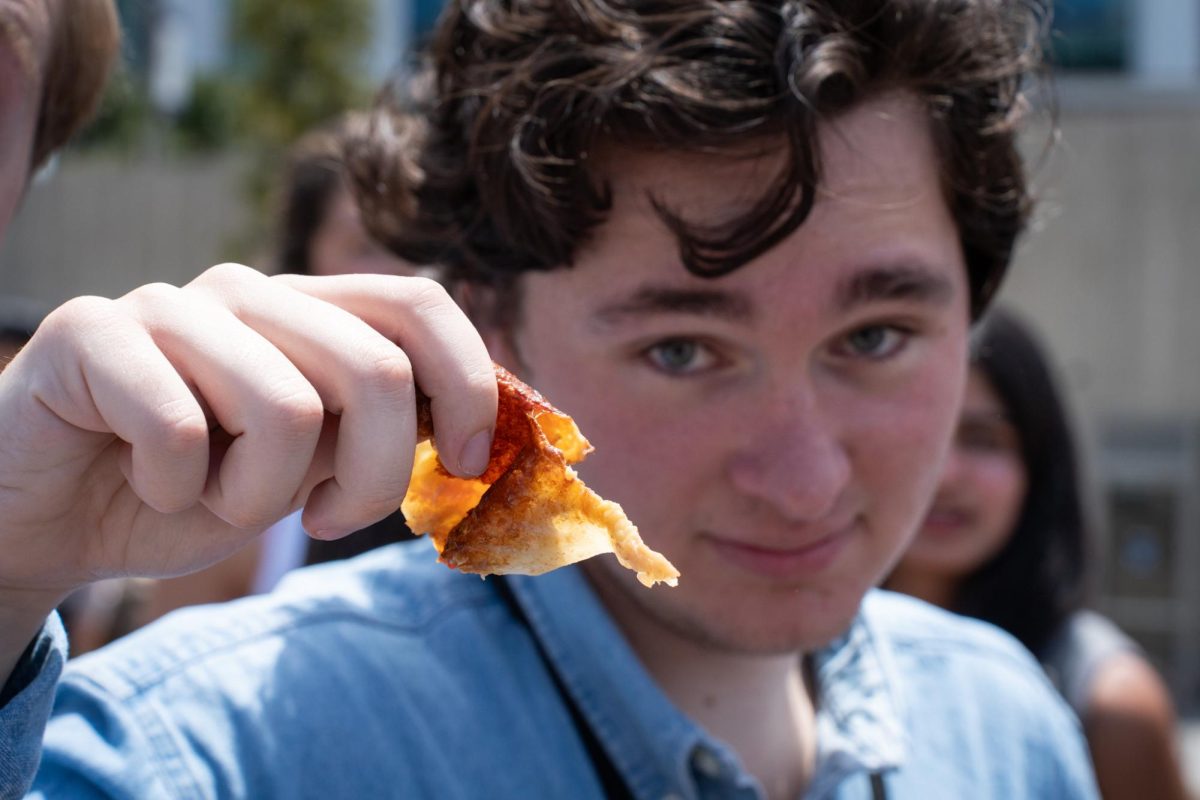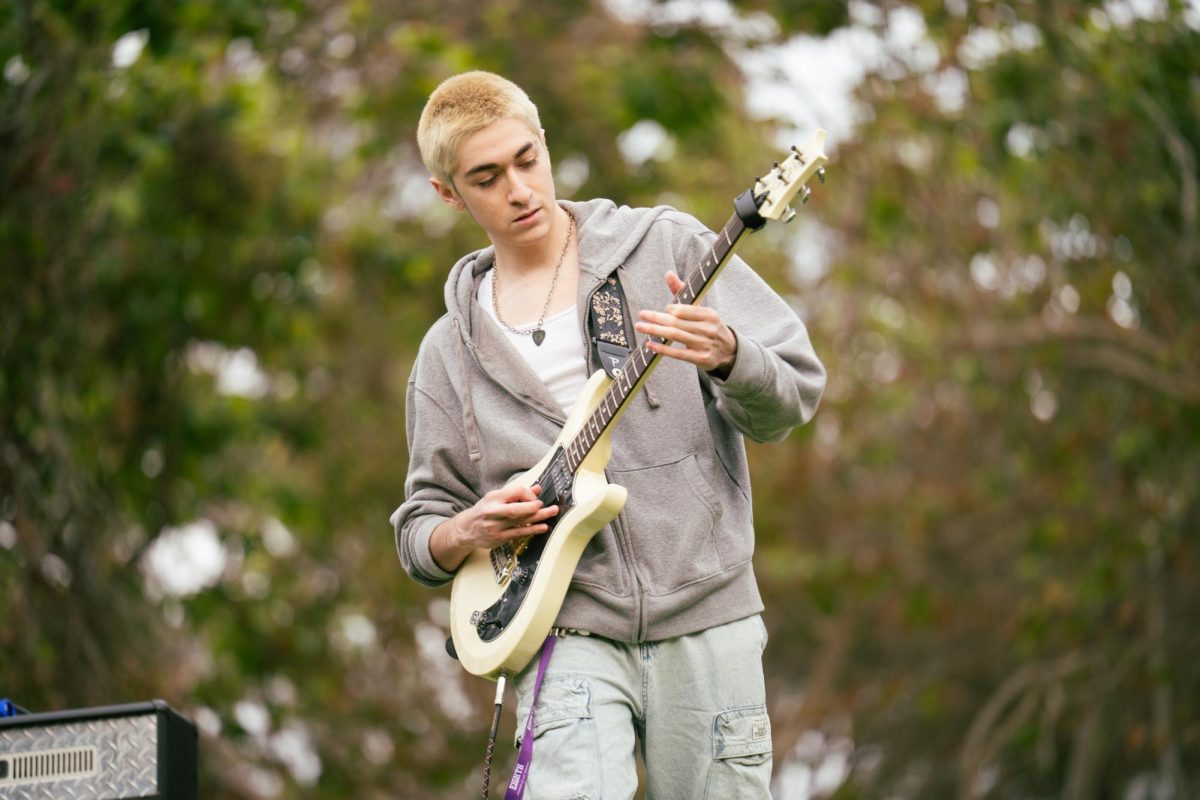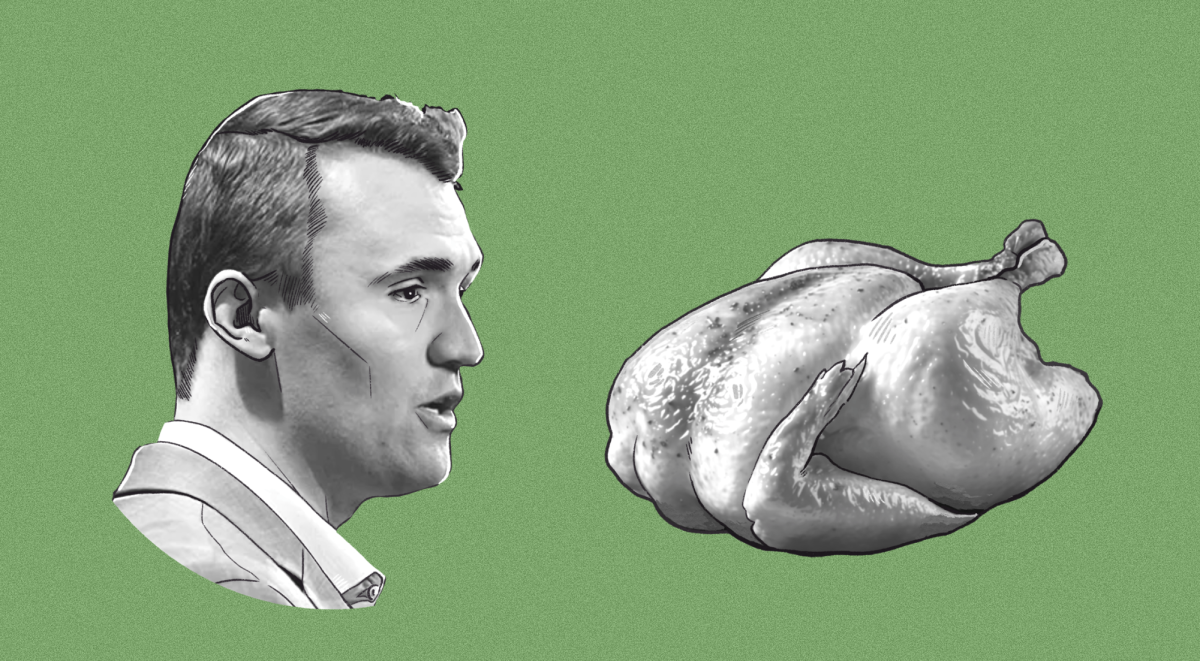Grinning from the cover of a booklet titled “”Discover UCSD”” are seven students. Clockwise from the top, there is an Asian female, a South Asian-looking male, a female of undetermined mixed heritage, a Hispanic female, a Caucasian male, a Caucasian female and an African-American male.
If the seven students are an accurate sample of the entire student body, UCSD’s ethnic breakdown would be as follows: 14 percent Hispanic, 14 percent African-American, 28 percent Caucasian, 28 percent Asian and 14 percent “”other.””
Some of this is fairly correct. A 28 percent Asian representation is similar to the actual 35 percent Asian UCSD undergraduates, the 26 percent Caucasian representation compares to the actual figure of 39 percent, and the 14 percent “”other”” representation is completely accurate.
However, the 14 percent African-American representation is far more generous than reality — 1 percent of UCSD’s undergraduate student body is African-American.
The cover photo of that booklet — the pages of which present statistics and information about UCSD and its student body — whether intended to accurately represent the university or not, sticks in the mind of some applicants and can influence their decision to apply to and subsequently attend UCSD.
Muir freshman Leila Dingding is one such student.
“”When I was applying to colleges, I really wanted to attend UCSD because they represented themselves as so diverse,”” Dingding said. “”Now that I’m actually here, I feel kind of like I was deceived.””
Most agree that an environment of diverse thought is important for a healthy exchange of ideas — a premise on which universities are founded. However, there is controversy over how such diversity is best achieved. Some, like Dingding, value racial and ethnic diversity, in which UCSD lags in comparison to other universities in California. The UC system, on the other hand, while drawing criticism for failing to admit a student population that is racially representative of the state, portrays its student body as varied in background if not in skin color.
“”The word that best describes the University of California student body is diverse,”” says the UC Pathways Web site, through which prospective students can learn about the UC system and submit applications.
The Pathways site continues, “”You will meet students from all walks of life at the university … Students from around the world and the country attend the university, but the majority are from California.””
UCSD also promotes ethnic and racial diversity, which is apparent within the UCSD Principles of Community. It states, “”We value the cultural diversity of UCSD because it enriches our lives and the university. We celebrate this diversity and support respect for all cultures, by both individuals and the university as a whole … We represent diverse races, creeds, cultures, and social affiliations coming together for the good of the university and those communities we serve.””
Vice Chancellor of Student Affairs Joseph Watson, when asked about campus diversity, said “”diversity [at UCSD] is very broad,”” and that “”the vast majority of students are satisfied with their experience at UCSD.””
The students have opinions of their own.
“”I would feel more comfortable if our school were more diverse,”” Dingding said. “”That way, I would experience more cultural awareness and understanding of our diverse society.””
Dingding completed UCSD’s ethnically diverse Summer Bridge preparation program before school began. She felt there was a startling contrast between the diversity she experienced through this program and that of the actual university.
Muir junior Greg Nichols said that UCSD’s diversity is “”pretty good, but some groups are under- or overrepresented. Some changes would be beneficial.””
Meanwhile, Marshall junior Tani Topracki feels differently.
“”Our school’s level of diversity is OK,”” Topracki said. She feels “”people’s individuality”” is more important — and that isn’t necessarily linked to skin color or ethnic background.
A.S. President Jeff Dodge said that racial and ethnic diversity is crucial because “”it’s not just an issue of numbers, it’s an issue of perspective.””
Dodge feels this apparent lack of diversity is reflected in the atmosphere on the UCSD campus as well as in the quality of education because, he said, the college experience is not just about classes, but the intermingling of unique individuals and perspectives.
“”We’re lacking in perspective of the world, America, culture and a sense of global identity,”” Dodge said. “”College is supposed to be a microcosm of society. It’s a time to be introduced to the basic ideas of other cultures.””
However, the numbers of enrolled minority students do not reflect the demographics of the state of California.
According to the 2000 census, Caucasians comprise 59.5 percent of Calfornia’s population. Those of Hispanic or Latino origins make up 32.4 percent. Asians make up 10.9 percent, African-Americans 6.7 percent and Native Americans 1 percent. Persons reporting some other race or mixed race descent total 21.5 percent. UCSD’s figures, as reported above, comparatively overrepresent Asians and underrepresent all other ethnic and racial groups.
“”It’s disturbing,”” Dodge said. “”The lack of ethnic diversity impacts [our] education.””
Watson acknowledges the disparity between California’s ethnic makeup and that of UCSD.
“”Certainly [the] campus is not reflective of the people of California,”” Watson said. “”Certain groups are severely underrepresented.””
Watson also said he does not feel that UCSD is doing enough to change.
But studies show the situation may be at least partially self-perpetuating. According to the university’s Diversity Council’s Web site, a survey of minorities admitted to UCSD who decided not to attend indicate two main reasons for their declination: inadequate distribution of competitive scholarships, and lack of a significant number of other minority students.
It has been argued that another trend is partially responsible for some students’ dissatisfaction with UCSD’s ethnic, racial and cultural diversity.
A.S. Vice President Internal Jennifer Brown said students themselves may be imposing a barrier to the exploration of differences and capitalization on the benefits of diversity by not associating with those of different backgrounds than their own.
“”Some students are even unable to embrace the diversity that is present on campus,”” Brown said.
Edwina Welch, director of the Cross Cultural Center, agrees. She said that many campus climate issues stem from self-segregation. “”You must be able to communicate, understand and engage to the best of your ability,”” she said. She said also that to succeed in the world, students will need to be open to ideas that lie outside their own experiences.
“”Everybody is impacted [by lack of diversity] — some people know they are impacted and some people don’t,”” Welch said. “”It just depends on where the lens is.”” She said that those who think diversity doesn’t impact them are those who should be most concerned.
Some are working to turn UCSD into a more racially diverse place.
UCSD is home to a number of ethnicity-specific student organizations such as the Hindu Students Council and the African-American Student Union. These organizations work to provide a community for members of the ethnic or racial groups they serve and often address issues of campus diversity.
Watson advocates such student-initiated efforts and feels that underrepresented students, if concerned, should take on some of the responsibility to make UCSD more attractive.
“”Any students working constructively to improve the situation should be commended,”” Watson said.
However, Dodge and Brown both cite a lack of financial support for diverse student organizations as a problem. Without these organizations, they said, underrepresented students lack needed support in the campus community.
Student opinions reflect controversy over the worth of ethnicity-based organizations.
“”There are a good number of ‘ethnic’ organizations [on campus], but I feel that most are not as active as they could be,”” said Tracy Mathews, a Warren senior, as she sat behind the Coalition of South Asian People booth on Library Walk.
Mathews feels CSAP “”is a start at something progressive for people like me.””
Nichols has mixed feelings about these organizations.
“”They develop unity. I’m not involved in one. I’m a white male Anglo-Saxon. [There aren’t] too many groups for me,”” Nichols said.
Revelle senior Robert Setterbo said he doesn’t agree with such race- or ethnicity-based organizations, saying, “”They promote unity as well as segregation.””
One of the primary diversity-oriented groups on campus is the Student Affirmative Action Committee, an independent body that works through the Student Affirmative Action and Human Relations Program at UCSD. SAAC acts to foster communication among organizations promoting cultural diversity throughout the university. It also works in outreach and retention of underrepresented groups on campus.
The Student Affirmative Action and Human Relations Program Web site claims SAAC “”exists to facilitate a university environment that attracts and nurtures a culturally diverse student body and provides equal opportunity and equity for all students.””
Jennifer Ganata, a Marshall junior, is an active SAAC member.
“”In considering higher education, some students simply lack opportunities that are afforded to others,”” Ganata said, adding that location and culture can be strong factors in determining these opportunities.
“”We don’t have a chance to establish a community … There are people working hard to change [the atmosphere], but it’s not diverse right now. When you look at classes, there are no African-Americans [and] few Hispanic people; it doesn’t represent California.””
Some students’ desire for diversity applies not only to filling the lecture halls — it also applies to the selection of the professors and staff who make learning possible at UCSD. But while many faculty members and those involved in hiring point out that since the passage of Proposition 209, it is prohibited in California to exclusively base hiring on race or ethnicity.
However, Ross Frank, chair of the Academic Senate Affirmative Action and Diversity Committee, says that more could be done.
“”Considering diversity as part of teaching and mentoring actually works under Proposition 209,”” Frank said.
Federal funding still favors institutions with diversity that reflects workforce demographics, Frank said. Proposition 209 allows loopholes for institutions that risk losing their federal funding. For an institution to receive optimal funding, its hiring practices must match up with the demographics of the available work force. But the enforcement of these guidelines can be lax.
Watson cited inaction and indifference as the causes of UCSD’s ethnic makeup.
“”The main stumbling block is that [the lack of racial diversity] is acceptable to people; it’s not a top priority,”” Watson said.
Watson said that increasing ethnic diversity is a near-universal desire, but when it comes down to it, few people make diversity a priority and “”it’s not going to happen by wishing it.””
Ganata said students like her aren’t just wishing — they’re acting to change the university.
“”The student voice is little in number, but loud,”” Ganata said.







